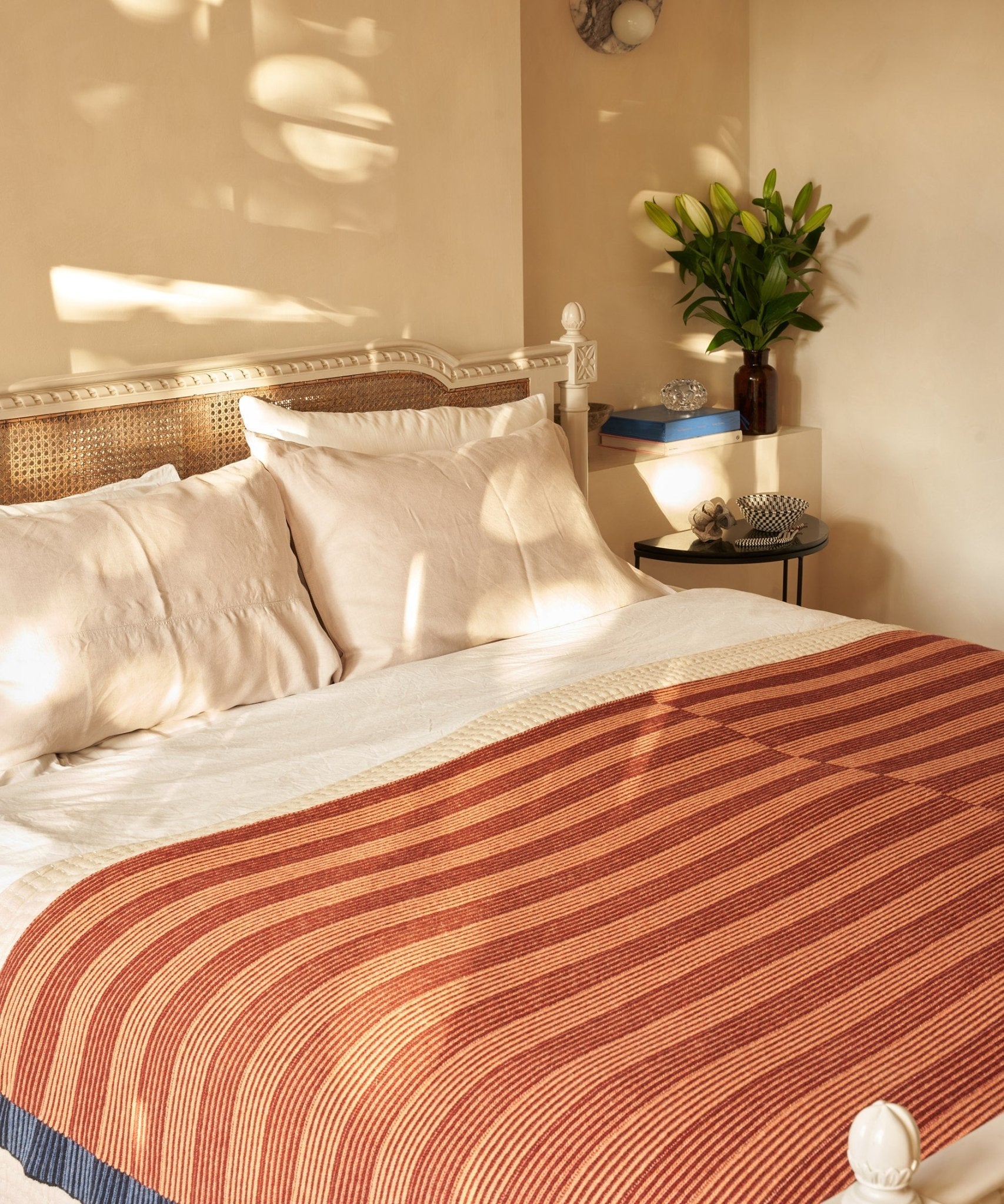How to Wash a Throw Blanket — 7 Simple Steps to Make Yours Like New, Including Treating Stains
Ahem, morning cup of Joe, we're looking at you


Some might think that caring for a throw blanket is the same as caring for a regular one. But because throws are often more about style, they might have tassels, fringe, or special dyes. These details can make them require a bit more maintenance, requiring cold water or even hand washing. Also, they’re often made from delicate or decorative fabrics like fleece, knit, or even fancy faux fur.
There are many types of bedding, and regular blankets don’t usually come with all the extras, so they’re less fussy to clean. Since they’re designed to be "thrown" over furniture or incorporated into other bedding styles, crumbs, lint, or pet hair might be clinging to them. Shake it outside or roll a lint roller over it. Sort it with similar items to avoid snagging, or throw it in a laundry bag if it’s super delicate.
Washing throw blankets isn’t complicated if you know the tricks—and our experts have learned a few as cleaning professionals. Here's a step-by-step guide to getting your throw blankets back to their soft, clean glory.
What You’ll Need

Before you begin cleaning your cozy bedding and the plush throw blanket, Jade Piper, the Operations Manager for BetterCleans suggest you gather these essential tools to ensure effective cleaning:
• Mild detergent: Choose a gentle, fabric-safe detergent like Seventh Generation Concentrated Laundry Detergent from Amazon to avoid any damage to delicate fibers.
• Great Value Distilled White Vinegar from Walmart (optional) – Ideal for naturally refreshing fibers and eliminating odors.
• Mainstays White Polyester Mesh Laundry Bag from Walmart – Perfect for protecting delicate, knitted, or fringe-accented blankets during the wash cycle.
The Livingetc newsletters are your inside source for what’s shaping interiors now - and what’s next. Discover trend forecasts, smart style ideas, and curated shopping inspiration that brings design to life. Subscribe today and stay ahead of the curve.
• Stain remover. Pre-treat stubborn spots with a trusted product like OxiClean Stain Remover Powder from Target or a similar enzyme-based solution.
• Cleaning Brush Soft Bristle Brush from Amazon (optional) – Great for spot cleaning stains without damaging fabric.
Drying rack or dryer with a low-heat setting — Protects against shrinking and keeps your blanket’s texture intact.
How to Wash a Throw Blanket

Here's a guide to washing a throw blanket for added comfort and style:
Step 1: Read the Care Label
“Every blanket is unique, so always start by checking the care label,” says Jade. “It will specify whether your blanket is machine washable, hand wash only, or dry clean only.”
This step is crucial for preserving your throw's texture and quality.
Step 2: Shake It Out
Before washing, take the blanket outdoors or over a clean surface and give it a good shake. This helps remove dust, pet hair, or loose debris that can clog your washing machine or impact cleaning efficiency.
Step 3: Spot Treat Stains
Inspect your blanket for stains or discolorations. Apply a stain remover to these areas, gently working it in with a soft-bristle brush or your fingers. Let it sit for 5–10 minutes before proceeding to wash.
Step 4: Select the Proper Washing Cycle
For machine-washable blankets, use a gentle or delicate cycle with cold water. This minimizes wear and tear, especially for knitted or plush materials.
Place delicate blankets in a mesh laundry bag to prevent snagging or stretching.
Step 5: Add Detergent
Measure a small amount of mild detergent. Avoid using fabric softeners, as they can leave a residue that diminishes the blanket’s softness.
Step 6: Drying Process
When drying, do not use a dryer unless the care label explicitly indicates that it is safe to do so. Gently press excess water from the blanket using a clean Utopia Towel or two.
Lay the blanket flat on a Honey-Can-Do Drying Rack from Target or a clean, dry towel, reshaping it to its original dimensions. For larger or heavier throws, first roll them in towels to absorb more water before air-drying, especially if you are low on laundry room storage. Following these steps will keep the throw blanket fresh, soft, and in perfect condition.
For delicate fabrics like wool or cashmere, Brunson Sayes, cleaning expert and founder of Breathe Maids recommends air drying as the safest option. “Lay the blanket flat on a drying rack, reshaping it as necessary, says Brunson. “For sturdy materials like cotton or polyester, use a low-heat setting in the dryer.”
Step 7: Fluff and Restore
Once your blanket is fully dry, give it a gentle shake or fluff by hand. This helps restore its softness and ensures it’s ready to use again. Add wool dryer balls from Amazon to reduce drying time and restore fluffiness.
FAQs
How often should I wash my throw blanket?
Wash throw blankets every 2–3 months or more frequently if they are heavily used.
When should I replace a throw blanket?
On average your throw blanket should last around 5 years before replacing.
And just like that, your throw blanket is ready for its next use. Keeping your throws clean doesn’t have to be a production, it’s all about using the right tools and taking a little extra care.
Proper care not only extends the life of your throw blanket but also ensures it remains a cozy addition to your home.

Seraphina is a contributing editor at Livingetc, writing Advice features on design, renovation and organisation. Seraphina is a qualified Interior Designer from KLC School of Design having worked at London-based interior design agencies Anouska Hempel and ND Studios. Seraphina has also completed her MA degree in Magazine Journalism at City, University of London, with previous experience including writing for Homes & Gardens, Women's Health, Food & Travel and Fabulous Magazine.